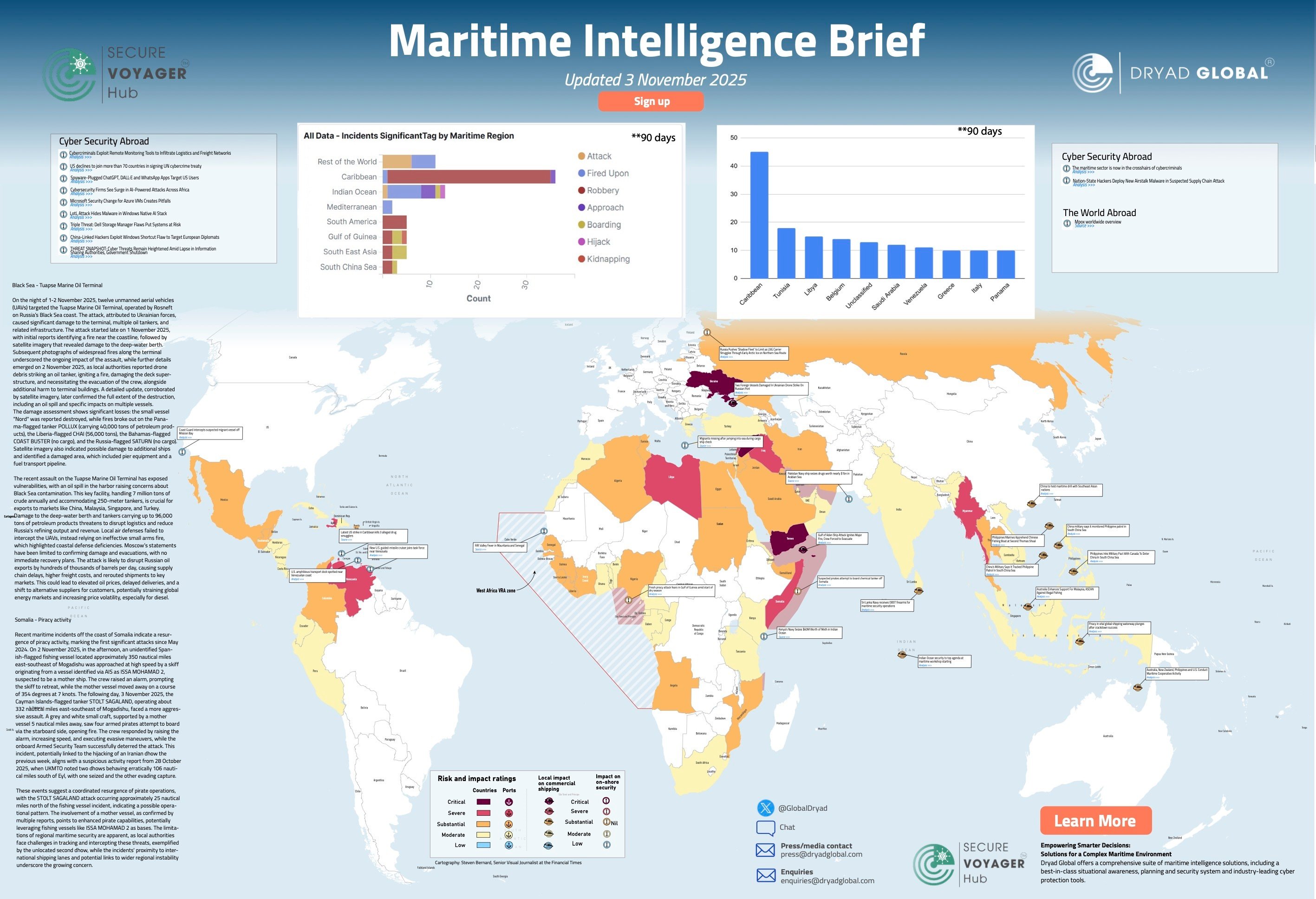4 min read
Weekly Maritime Intelligence Brief — 3 November 2025
By: Dryad Global on November 4, 2025 at 7:34 PM

This week’s brief highlights a high-impact UAV strike in the Black Sea, a renewed spike in Somali piracy activity, seasonal risk signals in the Gulf of Guinea, and a busy Indo-Pacific security picture—plus a roundup of cyber threats and health advisories relevant to crews and operations.
Black Sea: Tuapse oil terminal struck, tankers damaged
Twelve UAVs hit Rosneft’s Tuapse Marine Oil Terminal overnight 1–2 Nov, igniting multiple fires, damaging the deep-water berth and several tankers, and reportedly causing an oil spill within the harbor. Vessels affected included POLLUX (Panama), CHAI (Liberia), COAST BUSTER (Bahamas) and SATURN (Russia); the small vessel NORD was reported destroyed. Local air defence response proved ineffective, underscoring coastal security gaps. Expect short-term export disruption (hundreds of thousands of bpd), reroutings to Asian buyers, and higher freight/insurance costs on Black Sea lifts.
Operator notes: extra diligence on Black Sea calls (port state updates, berth availability, pollution controls), monitor war risk premiums, and confirm STS alternatives if scheduling shifts.
Western Indian Ocean: piracy attempts east-southeast of Mogadishu
After a relative lull since May 2024, two incidents 2–3 Nov point to a coordinated resurgence:
-
A Spanish-flagged fishing vessel ~350 nm ESE of Mogadishu was approached at speed by a skiff assessed to be deploying from mother vessel ISSA MOHAMAD 2 (via AIS). The skiff withdrew after the crew raised alarm.
-
The STOLT SAGALAND (Cayman Islands-flagged tanker) ~332 nm ESE of Mogadishu faced an armed boarding attempt by four pirates, supported by a mother vessel ~5 nm away. Alarm, speed and manoeuvres—plus the onboard Armed Security Team—repelled the attack.
These events may link to an Iranian dhow hijack the prior week and align with UKMTO reports of erratic dhow behavior near Eyl on 28 Oct, indicating pirate groups re-constituting capability via mother vessels.
Operator notes: apply BMP5 rigor at >300 nm from the Somali coast, maintain hardening and watch routines, and consider AST for transits along the Eyl–Socotra approaches.
Gulf of Guinea: dry-season alert
Analysts flag fresh piracy concerns as the dry season begins—historically associated with increased small-boat activity and longer-range attacks. Maintain heightened watch when operating off Nigeria, Benin, Togo and Ghana, especially beyond the VRA.
Americas & Caribbean: maritime security posture tightens
Regional reporting notes U.S. naval units operating near Venezuela, alongside maritime interdictions and drug-smuggling incidents that can affect coastal traffic and inspections. Operators should anticipate episodic checks and localized security restrictions in contested littorals.
Indo-Pacific: more drills, more friction management
-
China–ASEAN maritime drill activity;
-
Philippines–Canada pact to bolster deterrence in the South China Sea;
-
Australia, New Zealand, Philippines and U.S. cooperative maritime activity;
-
Philippine Marines enforcement actions around Second Thomas Shoal;
-
Expanded illegal-fishing countermeasures backed by Australia;
-
Sri Lanka Navy re-equips for maritime security.
Operator notes: expect notams/navwarnings, temporary exercise areas, and law-enforcement presence near disputed features and EEZ boundaries.
Cyber watch: logistics and fleets in the crosshairs
Threat reporting this week highlights:
-
Remote monitoring tool abuse to infiltrate logistics/freight networks;
-
A rise in AI-enabled attacks across Africa;
-
Risks tied to Azure VM configuration changes;
-
European diplomatic targeting via Windows shortcut exploits;
-
Trojanned consumer AI/chat apps (e.g., “ChatGPT”/“DALL·E” fakes) circulating spyware.
Operator notes: verify third-party RMM access, tighten MFA and least-privilege on cloud workloads, and block unapproved AI/mobile apps on crew and shore devices.
Health & crew: disease updates to watch
Advisories track Rift Valley Fever activity in Mauritania and Senegal, and a continuing mpox overview. Crewing and port calls in West Africa should include vector precautions and up-to-date medical guidance.
What operators should do this week
-
Re-screen Black Sea voyages for berth status, cleanup ops and routing; confirm insurance implications.
-
In the western Indian Ocean, enforce BMP5, practice citadel drills, and consider AST on vulnerable legs.
-
In the Gulf of Guinea, adjust watchkeeping and CPA thresholds; coordinate with coastal MSAs as the dry season advances.
-
Cyber hygiene: audit third-party access to TMS, voyage planning and terminal-interface systems; patch endpoints exposed to LNK/shortcut abuse.
-
Health planning: brief crews on RVF/mpox basics; validate medical kits and reporting lines for affected regions.
For deeper, port-specific and route-level analysis—or to integrate this feed into your voyage planning and security workflow—contact Dryad Global.
Related Posts
Turkey says Greek coast guard fires on cargo ship..
Greek coast guard ships opened fire on a cargo vessel sailing in international waters in the Aegean..
Two Guests on Royal Caribbean's Cruise Ship Test..
Cruise operator Royal Caribbean said on Thursday two guests onboard its Celebrity Millennium ship..
Pirates strike Pemex oil platform
A group of ten armed men has reportedly carried out another heist in the Gulf of Mexico, taking..




